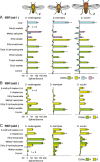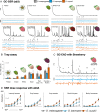Olfactory specialization in Drosophila suzukii supports an ecological shift in host preference from rotten to fresh fruit
- PMID: 25618323
- PMCID: PMC4351439
- DOI: 10.1007/s10886-015-0544-3
Olfactory specialization in Drosophila suzukii supports an ecological shift in host preference from rotten to fresh fruit
Abstract
It has been demonstrated that Drosophila suzukii is capable of attacking ripening fruit, making it a unique species within a fly family named for their attraction towards the fermentation products associated with rotten fruits, vinegar, and yeast. It also has been hypothesized that D. suzukii is more attracted to the volatiles associated with the earlier ripening stages of fruit development, and in turn, that D. suzukii is less attracted to fermented food resources, especially when compared with D. melanogaster. Here, we demonstrate that D. suzukii and its close relative D. biarmipes are in fact more sensitive to volatiles associated with the fruit-ripening process; however, in choice-assays, both spotted-wing species are more attracted to fermented fruit than to earlier stages of fruit development, which is similar to the behavioral preferences of D. melanogaster, and thus, fruit developmental stage alone does not explain the ecological niche observed for D. suzukii. In contrast, we show that both D. suzukii and D. biarmipes are more attracted to leaf odors than D. melanogaster in behavioral trials. For D. suzukii, this differential behavioral preference towards leaves appears to be linked to β-cyclocitral, a volatile isoprenoid that we show is most likely a novel ligand for the "ab3A" neuron. In addition, this compound is not detected by either of the other two tested fly species.
Figures



Similar articles
-
Electrophysiological and Behavioral Responses of Drosophila suzukii (Diptera: Drosophilidae) Towards the Leaf Volatile β-cyclocitral and Selected Fruit-Ripening Volatiles.Environ Entomol. 2019 Sep 30;48(5):1049-1055. doi: 10.1093/ee/nvz092. Environ Entomol. 2019. PMID: 31433837
-
Evolutionary shifts in taste coding in the fruit pest Drosophila suzukii.Elife. 2021 Feb 22;10:e64317. doi: 10.7554/eLife.64317. Elife. 2021. PMID: 33616529 Free PMC article.
-
Functional characterization and evolution of olfactory responses in coeloconic sensilla of the global fruit pest Drosophila suzukii.BMC Biol. 2025 Feb 21;23(1):50. doi: 10.1186/s12915-025-02151-9. BMC Biol. 2025. PMID: 39985002 Free PMC article.
-
Advances in the Chemical Ecology of the Spotted Wing Drosophila (Drosophila suzukii) and its Applications.J Chem Ecol. 2018 Oct;44(10):922-939. doi: 10.1007/s10886-018-1000-y. Epub 2018 Jul 27. J Chem Ecol. 2018. PMID: 30054769 Review.
-
The Protein Paradox: Elucidating the Complex Nutritional Ecology of the Invasive Berry Pest, Spotted-Wing Drosophila (Diptera: Drosophila suzukii).Front Insect Sci. 2021 Dec 23;1:787169. doi: 10.3389/finsc.2021.787169. eCollection 2021. Front Insect Sci. 2021. PMID: 38468895 Free PMC article. Review.
Cited by
-
Oviposition Suitability of Drosophila Suzukii (Diptera: Drosophilidae) for Nectarine Varieties and Its Correlation with the Physiological Indexes.Insects. 2019 Jul 24;10(8):221. doi: 10.3390/insects10080221. Insects. 2019. PMID: 31344965 Free PMC article.
-
Mass Trapping Drosophila suzukii, What Would It Take? A Two-Year Field Study on Trap Interference.Insects. 2022 Feb 28;13(3):240. doi: 10.3390/insects13030240. Insects. 2022. PMID: 35323538 Free PMC article.
-
Functional olfactory evolution in Drosophila suzukii and the subgenus Sophophora.iScience. 2022 Apr 6;25(5):104212. doi: 10.1016/j.isci.2022.104212. eCollection 2022 May 20. iScience. 2022. PMID: 35573203 Free PMC article.
-
Evolution of olfactory circuits in insects.J Comp Physiol A Neuroethol Sens Neural Behav Physiol. 2020 May;206(3):353-367. doi: 10.1007/s00359-020-01399-6. Epub 2020 Jan 27. J Comp Physiol A Neuroethol Sens Neural Behav Physiol. 2020. PMID: 31984441 Free PMC article. Review.
-
Phenolics as ecologically relevant cues for slime flux breeding Drosophila virilis.iScience. 2024 Oct 18;27(11):111180. doi: 10.1016/j.isci.2024.111180. eCollection 2024 Nov 15. iScience. 2024. PMID: 39555411 Free PMC article.
References
-
- Atallah J, Teixeira L, Salazar R, Zaragoza G, Kopp A (2014) The making of a pest: the evolution of a fruit-penetrating ovipositor in Drosophila suzukii and related species. Proc Royal Soc London B: Biological Sciences 281. (http://dx.doi.org/10.1098/rspb.2013.2840) - PMC - PubMed
-
- Basoalto E, Hilton R, Knight A. Factors affecting the efficacy of a vinegar trap for Drosophila suzukii (Diptera; Drosophilidae) J Appl Entomol. 2013;137:561–570. doi: 10.1111/jen.12053. - DOI
-
- Calabria G, Maca J, Bachli G, Serra L, Pascual M. First records of the potential pest species Drosophila suzukii (Diptera: Drosophilidae) in Europe. J Appl Entomol. 2012;136:139–147. doi: 10.1111/j.1439-0418.2010.01583.x. - DOI
-
- Carson HL, Stalker HD. Natural breeding sites for some wild species of Drosophila in the Eastern United States. Ecology. 1951;32:317–330. doi: 10.2307/1930422. - DOI
Publication types
MeSH terms
Substances
Grants and funding
LinkOut - more resources
Full Text Sources
Other Literature Sources
Molecular Biology Databases

